This guide is designed to provide you with a comprehensive understanding of standard lighting requirements for baseball and softball fields. Whether you are outfitting a field for recreational play or a professional level of competition, this guide will delve into the essential aspects of Lux (illuminance) and lighting uniformity. We will explore the recommended lighting levels for different types of games and field specifications, ensuring that you have a clear picture of what is needed. By the end of this guide, you will be equipped to plan an optimal lighting solution that ensures your field is perfectly illuminated, enhancing visibility and performance for players and spectators alike.
Table of Contents
ToggleWhy Do We Need a Good Baseball Field Lighting Design?
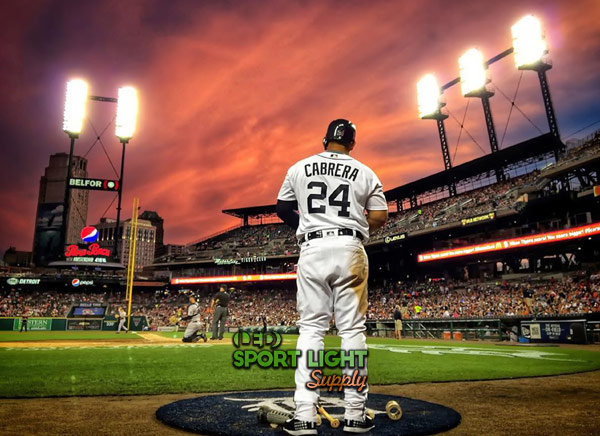
Improved Player Vision
Playing at night can present challenges if the infield or outfield is not illuminated adequately. Clear visibility is essential for players to track the ball, whether it’s in flight or on the ground. Proper lighting allows players to better judge the trajectory and speed of the ball, which is vital for successful fielding, hitting, and base running. Additionally, good lighting facilitates team coordination, helping players execute plays with precision, such as making strategic decisions during loaded bases or defending against base stealers.
Creating an Atmosphere for Spectators
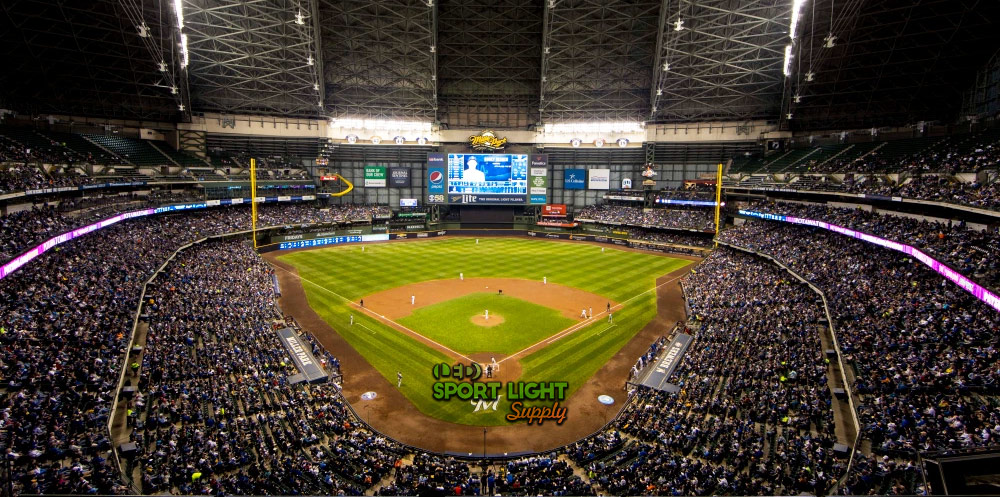
Baseball is more than just a game; it’s an experience enriched by tradition and shared enthusiasm. The right lighting can significantly enhance the atmosphere for spectators, turning an ordinary game into an unforgettable event. Beyond basic illumination, creative lighting designs can include dynamic effects and color schemes that highlight key moments and transitions during the game. Special lighting packages can elevate the mood of the ballpark, adding a dramatic flair that keeps the energy high and the experience enjoyable for fans.
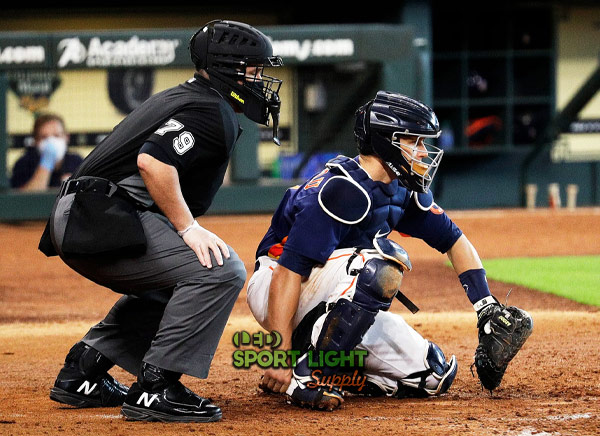
Better Lighting for Referees
Referees play a critical role in maintaining fairness and accuracy during a game, and adequate lighting is essential for them to perform their duties effectively. Proper field lighting ensures that referees can clearly see and make precise judgments on plays. Inadequate lighting can obscure details, making it difficult to assess whether a player is following the rules or engaging in unsportsmanlike conduct. By providing ample illumination, you ensure that referees have the visibility they need to uphold the integrity of the game.
How to Get Started with Baseball & Softball Field Lighting Layout
Number of Baseball Field Light Poles
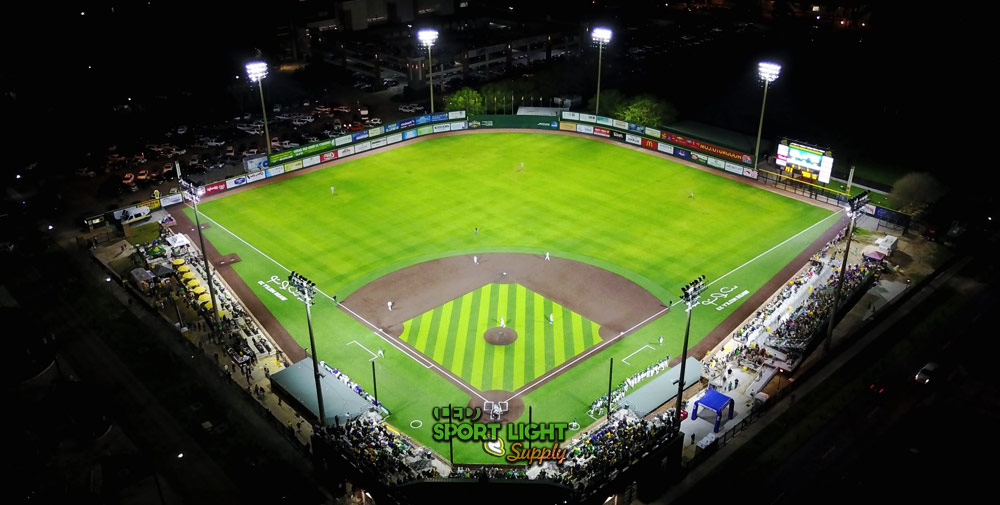
The number of light poles required for a baseball or softball field depends on various factors, including the field’s size and the level of play it is designed for. Typically, fields may use anywhere from 4 to 8 poles. Smaller fields or those intended for recreational play may require fewer poles, while larger fields or those used for more competitive games might need more poles to ensure adequate illumination. Our team can help assess the specific needs based on the field’s dimensions and other lighting requirements. The final decision will also be influenced by additional factors such as the type of lighting fixtures and the desired brightness levels.
Stadium Light Pole Position
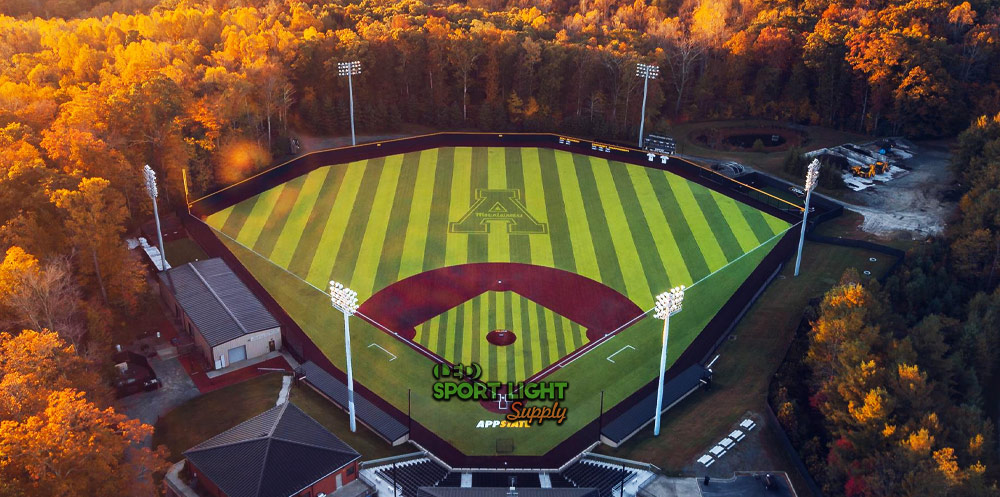
Proper positioning of light poles is crucial for achieving optimal lighting. Generally, light poles are placed at the corners or along the sidelines of the field. To create the best lighting plan, it’s important to determine the appropriate pole height and estimate the necessary wattage levels. Careful placement of the poles helps minimize glare for both players and spectators and ensures even light distribution across the field. The arrangement of poles must be strategically planned to meet the uniformity requirements and provide consistent lighting across all areas of play.
Baseball Field Pole Height
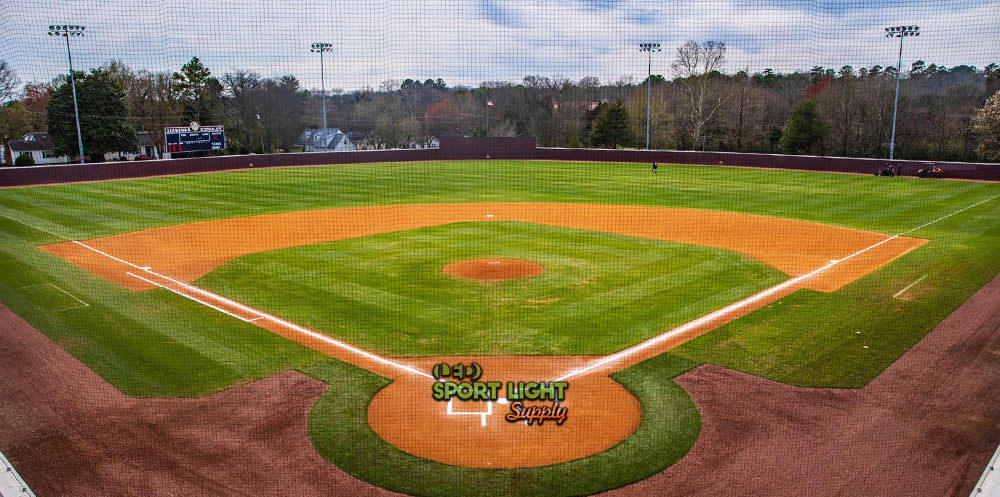
The height of the light poles varies depending on the level of play and the specific needs of the field:
| Lighting Level | Pole Height Range | Description |
|---|---|---|
| Recreational/Training | 12 to 15 meters | Ideal for local city ballparks, schools, and sports centers where basic lighting is sufficient. Cost-effective for younger players and recreational games. |
| High School/College | 15 to 40 meters | Accommodates larger field sizes and provides better illumination for both players and spectators. Higher wattage is required for effective lighting. |
| MLB National/International Tournaments | 25 to 60 meters | Ensures maximum illumination and meets regulatory standards for professional and international games. High-intensity lights support high-level play and visibility. |
Infield and Outfield Lighting
Different areas of the field may require different lighting levels. The infield, where most of the game’s action occurs, generally needs brighter lighting to ensure clear visibility for players and referees. Adequate lighting in the infield helps in accurate decision-making and enhances player performance. In contrast, the outfield usually requires less intense lighting since it is less frequently involved in play. Lower light levels in the outfield help prevent glare and allow players to track the ball more effectively without being overwhelmed by bright lights.
Goals of Baseball Field Lighting Design
Proper Amount of Lux (Brightness Level)
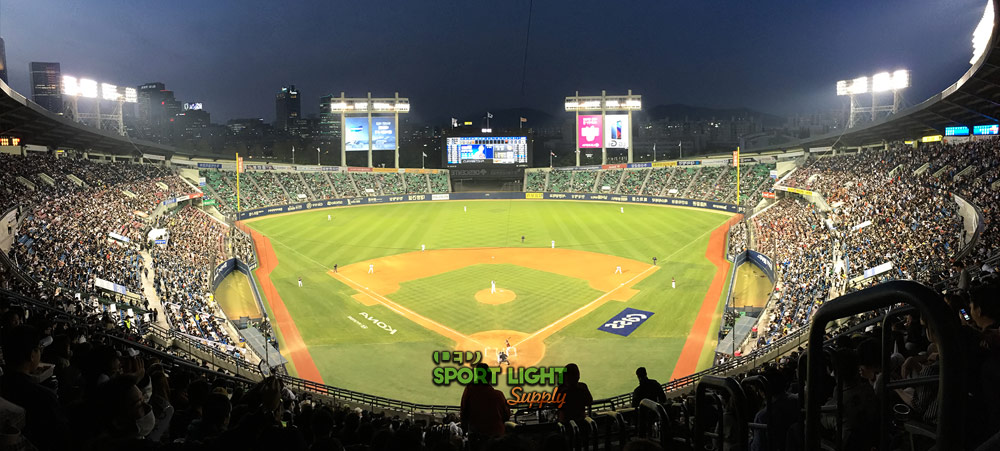
The appropriate Lux level is crucial for ensuring clear visibility and optimal performance on the field. Lux measures the brightness of light falling on the field, and different levels are required based on the field’s usage and level of play.
For recreational fields and local baseball clubs, the Lux level typically ranges from 200 to 400. This range provides sufficient brightness for casual play, allowing players and the field to be seen clearly without excessive glare. While this level is adjustable according to the needs of the field, a higher Lux level generally offers better visibility.
Intermediate and semi-professional fields, such as those used for training or college baseball, should have Lux levels between 500 and 1000. This level of illumination enhances visibility for players and referees, allowing for precise play and accurate decision-making. It provides a level of brightness comparable to that used in office lighting or auto body paint shops.
Professional fields, including those used for major league or international tournaments, require much higher Lux levels, ranging from 750 to 2000. The infield typically receives twice the Lux level of the outfield to accommodate the intense action that occurs in this area. For example, if the infield requires 1000 Lux, the outfield may need 500 Lux. This significant difference ensures that the infield is brightly lit to support high-level play and broadcasting needs.
| Field Type | Lux Level Range | Example Configuration |
|---|---|---|
| Recreational/Baseball Club | 200-400 Lux | Adequate for casual play |
| Training/College Baseball | 500-1000 Lux | Enhanced visibility for intermediate play |
| MLB National/International Tournament | 750-2000 Lux | Higher illumination with infield at 2x the outfield |
Lighting Uniformity
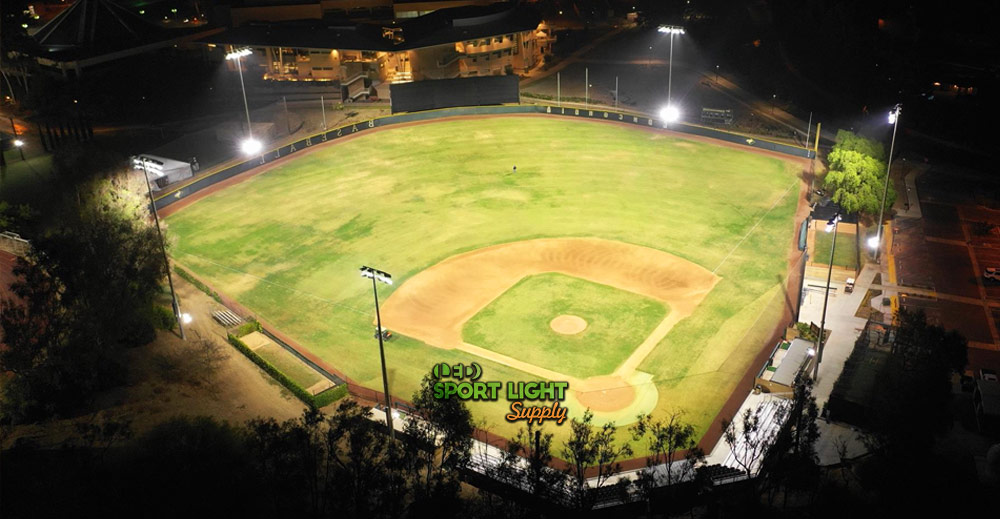
Lighting uniformity ensures that the entire field receives an even distribution of light. It involves measuring Lux levels across different sections of the field and creating a map to assess how consistently the field is lit.
For training fields, a lighting uniformity rating of 0.5 is generally acceptable, with Lux levels ranging from 200 to 400. This rating indicates that while there may be some variation in light levels, the field is adequately illuminated for recreational play.
In professional settings, lighting uniformity needs to be higher, ranging from 0.6 to 0.7. This is achieved with Lux levels between 500 and 2000, ensuring consistent illumination across the field. Higher uniformity is crucial for high-level play and broadcasting, where precise lighting is essential.
Beam Angle
The beam angle of lighting fixtures affects how light is distributed across the field. For long-range lighting, a beam angle of 15 to 45 degrees is recommended. This angle allows the light to spread effectively over long distances, ensuring broad coverage of the field.
For lights positioned closer to the infield, such as those along the sidelines, a beam angle of 60 to 90 degrees is more appropriate. This wider angle provides more concentrated illumination where it is needed most, particularly in the infield area.
Angle of Projection
The angle of projection is vital for maximizing lighting efficiency and uniformity. Properly angling high mast flood lights helps achieve optimal coverage and minimize light loss. Accurate calculations of the distance and beam angle ensure that each section of the field is well-lit, reducing the risk of uneven lighting and improving overall visibility.
Glare
Managing glare is an important aspect of modern baseball lighting. Traditional lighting technologies like halogen, high-pressure sodium, and metal halide required special lenses and shields to reduce glare. However, LED lights offer improved glare control through tighter beam angles and advanced optics, minimizing the impact on players and spectators. This enhancement results in a more comfortable viewing experience and reduces distractions.
Flicker-Free Lighting
Flicker-free lighting is essential for high-definition broadcasts and slow-motion footage. LED lights are preferred for their ability to provide flicker-free illumination, due to their rapid flash pulse rates. This feature is crucial for television broadcasts, where flicker can be detected by cameras and affect the quality of the footage. Unlike older technologies, LED lights eliminate flicker issues, ensuring clear and stable visuals for both live audiences and viewers at home.
What Lights Are Used in Baseball or Softball Stadiums?
High Power LED Floodlights
High power LED floodlights are commonly used for baseball and softball fields due to their versatility and efficiency. Typical wattages for these lights range from 400 to 2000 watts, making them suitable for various levels of play—from recreational games to professional events. These floodlights provide bright, even illumination, ensuring that the entire field is well-lit and that players can perform at their best regardless of the level of competition. Whether you’re lighting a local park or a major league stadium, high power LED floodlights can be tailored to meet your specific needs.
High Mast Lighting
High mast lighting is essential for large baseball and softball fields, especially those used for professional and high-level games. These lights are positioned on tall poles and feature narrow beam angles, typically ranging from 15 to 45 degrees. This design helps focus the light on the field, reducing light spillage and minimizing light pollution. The precise beam angle ensures that light is distributed uniformly across the field, improving visibility and performance for players and spectators alike. Properly positioned high mast lights are crucial for maintaining consistent lighting quality throughout the game.
Color-Changing Lights
Color-changing lights add an extra layer of excitement to baseball games, particularly during moments when the action slows down. The 7th inning stretch, for instance, provides an ideal opportunity for a dynamic light show that can entertain the crowd and enhance the overall game experience. These lights can be programmed to create vibrant displays during key moments, such as home runs or special plays, adding a spectacular visual element that elevates the atmosphere of the event. By incorporating color-changing lights, you can transform the stadium environment and make each game a memorable experience for fans.
Advantages of Using LED Lights in a Baseball Stadium
Energy Efficient
LED lights offer significant energy efficiency compared to traditional lighting options such as high-pressure sodium (HPS), halogen, or metal halide. LEDs consume considerably less wattage—typically around five times less—resulting in substantial cost savings on energy. This reduced wattage not only lowers the running costs but also contributes to a more sustainable and cost-effective lighting solution for baseball stadiums.
Longer Lifespan
One of the standout benefits of LED lighting is its exceptional lifespan, which often exceeds 150,000 hours. Unlike traditional bulbs, where components such as filaments and internal electronics may fail over time, LED diodes have a much longer operational life. Although internal electronics within the LED driver may eventually need replacement, the LED bulbs themselves rarely need changing, reducing maintenance efforts and costs.
No Warm-Up Time
Traditional metal halide lamps can take between 5 to 15 minutes to reach full brightness and suffer from reduced performance over their lifespan. Additionally, if there is a power outage, these lights require cooling before they can be restarted. In contrast, LED lights provide instant illumination and can be turned on and off repeatedly without any operational issues. This capability makes LEDs a more reliable and convenient choice for dynamic and fast-paced environments like baseball games.
Smart Lighting Control System
LED lighting systems can be integrated with advanced control systems that allow for sophisticated management of lighting effects. Technologies such as DMX and DALI enable precise control over light sequencing, dimming, and pre-programmed effects. Modern systems even support smartphone integration, offering flexibility to control lighting remotely. This functionality enhances the ability to create engaging light shows and effects tailored to specific moments during a game. Contact us to learn more about incorporating these smart lighting solutions into your baseball and softball field.
Light-Weight
LED fixtures are generally lighter than their traditional counterparts, which simplifies installation and reduces the need for reinforcing existing light poles. This is particularly important if your current poles were designed for heavier standard filament lights. While LED fixtures are lighter, it is still advisable to ensure that poles are adequately reinforced to support the new lighting equipment, ensuring stability and longevity.
Common Mistakes with Baseball Field Lighting Design
The Light Poles Are Too Short
How to Fix
Use More Floodlights with a Narrow Beam Angle
If the light poles are too short, using additional floodlights with a narrow beam angle can help extend the reach of the light. A narrow beam angle, ranging from 15 to 45 degrees, allows the light to travel further and spread more evenly across the field, improving overall illumination.
Increase the Number of Light Poles
Adding more light poles can help distribute light more uniformly across the field. For example, if you currently have 3-4 poles, increasing the number to 6-8 can ensure that each pole covers a smaller area, enhancing visibility for both players and spectators.
The Light Poles Are Too Tall
How to Fix
Use More Lights to Compensate for Light Loss
Tall light poles can cause light loss and increase light pollution. To counteract this, consider using additional lights to achieve adequate illumination. LED lights are a good option as they provide efficient lighting and can reduce the overall cost associated with high wattage.
Adjust the Height of the Poles
If you already have tall poles, you might be able to modify them by cutting and re-welding to the appropriate height. This adjustment should align with the size of the field and the level of competition. Consulting a contractor experienced in pole modification can help achieve the best results.
The Baseball Field Lights Are Too Bright
How to Fix
Reduce Glare and Light Pollution
Overly bright field lights can cause significant issues such as glare and light pollution, which not only affect player performance but also contribute to higher electricity costs and frequent maintenance. Traditional filament lights, such as metal halide and high-pressure sodium (HPS) lamps, often produce excessive glare and scatter light in unwanted directions. This leads to a decrease in visibility and can be distracting for both players and spectators.
Switching to LED lights offers a practical solution to these problems. LEDs are designed with advanced optics and precise beam control, which significantly reduces glare and light spill. The focused light distribution of LEDs ensures that illumination is directed exactly where it is needed on the field, minimizing light pollution and enhancing overall visibility. This results in a more comfortable viewing experience and reduces the need for continuous repairs and adjustments.
Obtain a DIALux Photometric Report
To address issues related to brightness and ensure optimal lighting conditions, obtaining a DIALux photometric report is highly recommended. This comprehensive lighting simulation provides a detailed view of Lux levels and light uniformity across a 3D model of your baseball field. The report simulates how the lighting will appear from various angles and helps identify areas where the brightness may be too intense or uneven.
By analyzing the DIALux report, you can make informed decisions about adjusting the lighting setup to achieve the desired balance of brightness and uniformity. This tool allows you to visualize potential improvements and fine-tune the lighting design before making any physical changes. We offer this valuable service free of charge to assist you in creating a well-lit field that meets your specific requirements and enhances the game experience for everyone involved.
Wrong Color Temperature
How to Fix
Choose the Right Color Temperature for Your Needs
Color temperature is a critical factor in lighting design, influencing both visibility and the overall ambiance of the baseball field. Different lighting technologies emit light at various color temperatures, measured in Kelvin (K), which can significantly affect the comfort of players and the quality of the viewing experience for spectators.
With LED lights, you have the flexibility to select the most appropriate color temperature for each level of play, ensuring that the lighting is optimized for the specific needs of the game:
| Level | Color Temperature | Description |
|---|---|---|
| Recreational | 3000K | Provides a warmer, softer light that creates a relaxed atmosphere. Ideal for casual play and avoids harsh shadows or discomfort. |
| High School/College | 5000K | Offers cooler, daylight-like illumination to enhance visibility and reduce color distortion. Helps players see the ball clearly and aids referees. |
| Major League/National/International | 6000K | Provides very cool, daylight-quality light essential for high-definition broadcasts and large audiences. Ensures excellent color rendering and visibility. |
Selecting the correct color temperature is vital for achieving optimal lighting conditions that suit the level of competition. Properly chosen color temperatures not only enhance the visual clarity of the field but also contribute to a better overall game experience. By aligning the lighting with the specific requirements of each level, you ensure that players perform at their best and viewers enjoy a clear, vibrant presentation of the game.
Our Final Conclusion
Understanding the intricacies of baseball field lighting can significantly impact your field’s performance and overall experience. If you’re ready to enhance your lighting setup, we can assist in arranging a tailored lighting package to meet all your needs. Whether you require lights on poles, special controls, or a detailed DIALux report, we’re here to guide you through the process. Contact us today to get started on improving your baseball or softball field lighting.
